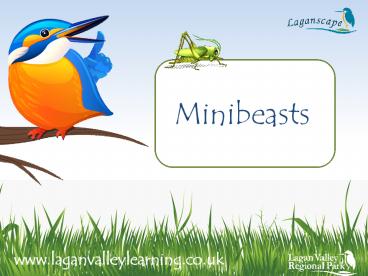What is a minibeast? PowerPoint PPT Presentation
Title: What is a minibeast?
1
Minibeasts
www.laganvalleylearning.co.uk
2
What is a minibeast?
- A minibeast is a small animal or creepy crawly.
- Minibeasts have no backbone .
- Minibeasts do not have a skeleton on the inside.
- Some minibeasts have a hard shell to live in.
- Minibeasts can be found on land, water and air.
- There are lots of different kinds of minibeasts.
Can you name any?
3
How are minibeasts different from us?
- We have our skeletons inside our bodies.
Minibeasts have their skeletons outside their
body. - Minibeasts have soft bendy bodies.
- Some minibeasts have a hard shell to protect them.
Worms have soft bodies
Snails have soft bodies and a hard shell
4
What do minibeasts need to survive?
Shelter
Food
Water
5
What do minibeasts eat?
Some minibeasts eat plants they are called
herbivores.
Some minibeasts only eat meat they are called
carnivores.
Some minibeasts eat both plants and meat they
are called omnivores.
6
What do minibeasts live?
- A minibeasts home is called a habitat
- A habitat is where a minibeast lives. It is more
than just a home as it includes everything an
animal needs to survive (food, water and
shelter). A habitat could be as big as a forest
or as small as a leaf. - Can you think of a good habitat for a minibeast?
7
Can you think of any minibeasts that might live
in these habitats?
Under a log
On a plant or tree
In a pond
In the soil
8
Sorting minibeasts
- You can sort minibeasts by the number of legs
they have. - 0 legs Worms, snails, slugs
- 6 legs Insects beetles, butterflies, bees,
ladybirds - 8 legs Spiders
- 14 legs Woodlouse
- More than 14 legs Millipedes and Centipedes
9
Slugs and snails
- Live in dark, damp habitats. Can you think of a
good snail habitat? - Have soft bodies and sometimes hard shell
- Have long tentacles with eyes on them
- They eat plants so they are called herbivores
- What do you think eats slugs and snails?
Tentacles With eyes
Shell
Tentacles for smelling
10
Earthworms
Earthworms live in the soil. They have soft
bodies that are made of segments. They eat soil
and make it healthy for trees and plants to
grow. They have a mouth but no eyes or nose.
Can you think of anything that might eat worms?
11
Insects
- Insects have 6 legs.
- They have feelers called antennae to smell and
feel. - Insects have 3 body parts
- Head
- Thorax (Belly)
- Abdomen (Bottom)
- Some insects have wings.
- Some insects are herbivores and some are
carnivores.
Can you label this insect?
12
How many insects can you name?
13
Spiders
- Spiders have 8 legs.
- They have a hard outer skeleton.
- They do not have antennae.
- They use their front legs for catching food.
- They are carnivores.
- Some spiders spin webs to catch their prey.
- Some spiders hide and pounce on their prey.
- Spiders are predators.
14
Woodlice
- Woodlice have 14 legs.
- They have 2 antennae.
- They have a hard outer skeleton.
- They live in dark damp habitats.
- They are herbivores.
- They are related to crabs and lobsters.
- As they grow they moult. This means that
- they shed their old skin and grow a new one!
Some people call them slaters
15
Centipedes
- Centipedes are reddish brown.
- They have 2 antennae.
- They have segmented bodies.
- They have 1 pair of legs on each body segment.
- They usually have about 15 pairs of legs and can
move very fast. - They are carnivores and even eat other
centipedes! - They are predators.
16
Millipedes
- Millipedes live in the soil.
- Their body is made of segments.
- They have 2 pairs of legs on each body segment.
- They are herbivores.
- If they are frightened they roll up into a ball.
17
Helpful minibeasts
Some bees make honey. All bees help flowers to
grow. Worms make the soil healthy for plants to
grow. Ladybirds help gardeners by eating aphids.
Can you think of any harmful minibeasts?
18
Lifecycle
Some minibeasts have a life cycle where the young
minibeast is very different from the adult. Look
at the life cycle of a butterfly. Can you see
the 4 different stages?
3.
2.
4.
Can you put these in the right order? Chrysalis,
Egg, Butterfly, Caterpillar
1.
19
www.laganvalleylearning.co.uk

